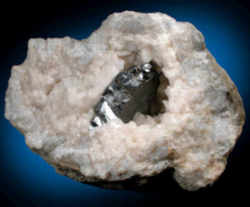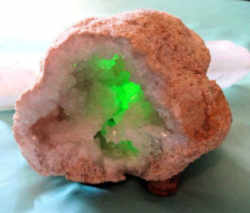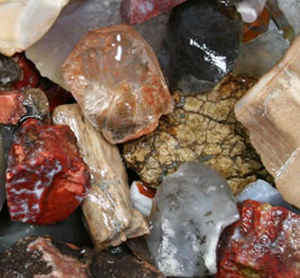Iowa State Rock
Geode

Adopted in 1967.
Because Iowa is well known for the presence of the Geode, it was chosen as the official rock in 1967 as an effort to promote tourism in the state. Iowa is now known worldwide because of the large number of rare and beautiful geodes found in this area.
Legislators who favored making the Geode the state rock pointed out that it is among the rarest and most beautiful of rocks and that Iowa is known worldwide because of the large number found in the state. Other rocks considered for official status were limestone and fossil coral.
Iowa State Rock: Geode

In Latin, the word "geodes" means "earthlike." Geodes are shaped like the earth and average about four inches in diameter. Geodes are found in limestone formations and have a hard outer shell. When carefully broken open, a sparkling lining of mineral crystals, most often quartz and calcite, is revealed.
Geodes have drab, rounded exteriors with a hard outer layer and partially hollow cavity lined with crystals. Some geodes are completely filled with small compact crystal formations such as agate, jasper or chalcedony and are called nodules. The only difference between a geode and a nodule is that a geode has a hollow cavity, and a nodule is solid.
Geodes are technically sedimentary rocks, since they are the result of the action of water. Geodes are formed when cavities in a host rock (which may be sedimentary or igneous) become lined with a durable mineral, often a variety of quartz
Geodes begin as bubbles in volcanic rock or as animal burrows, balls of mud or tree roots in sedimentary rock. Over a period of millions of years, layers of silica cool, forming crystals of different minerals within the cavity. Different types of silica cool at varying temperatures, thus creating layers of different types of mineral crystals. The silica precipitation can contain many varieties of dissolved minerals, the most common being quartz, but calcite, amethyst and many others are also found.
The conditions of formation create distinctive shapes. Some geodes are nearly perfect spheres. Others are teardrops, still others rounded tops with flattened bottoms. Some are lens shaped (convex tops and bottoms, often shallow), and many are rather irregular. Some large geodes have multiple interconnected pockets.
Geodes provide a sheltered environment for the growth of beautiful crystals, and sometimes rare minerals found nowhere else. Many of the world's best crystal specimens have been found inside of geodes. Some extremely rare minerals have been identified because the pristine environment of a geode allows a unique crystal to form, one that looks out of place and clearly a different mineral from the bulk of those around it.
Why Are Keokuk Geodes Special?

Keokuk Geodes are famous for their sparkling interiors containing some of the most beautiful crystals and minerals in the entire world
Quartz is the dominant mineral found in Keokuk Geodes and shimmering white to transparent quartz crystals fill the walls of many of these geode cavities but 19 additional minerals have also been identified including:
- Aragonite (occurs as groups of colorless to white crystals, very rare.)
- Barite (Crystals range from colorless to white, yellow, pink and pale blue.)
- Calcite (occurs as common crystals, dogtooth and nailhead types with colors white, brown and rarely pink.)
- Chalcedony (a microcrystalline mineral ranging in color from gray, black, blue, orange, red and the rare green. Chalcedony also makes up the geodes outer shell.)
- Chlorite (very rare black to gray coatings on crystals.)
- Chalcopyrite (crystals range from bright gold to bronze.)
- Dolomite (pink, brown or buff saddle shaped crystals sometimes dominate the entire geode cavity.)
- Goethite (occurs as black shiny elongated crystals.)
- Gypsum (crystals are long and clear or colorless also appears as flakes or grains.)
- Hematite (rare but occurs as tiny red crystals.)
- Jarosite (occurs as yellow to brown granular masses usually coating pyrite or marcasite, sometimes confused as sulpher.)
- Kaolinite (a bright white to brown clay mineral which usually fills the entire geode cavity.)
- Malachite (green inclusions and microscopic crystals.)
- Marcasite (occurs as masses of small crystals with a brassy or bronze color sometimes with a greenish tint.)
- Pyrite (occurs as reddish, gold or black cubic or capillary crystals.)
- Pyrolusite (usually appears as black stains on quartz.)
- Quartz (occurs as drusy crystals or large defined crystals ranging in color from clear, green, smoky, pink and the famous and rare citrine/orange.)
- Siderite (occurs as thin coatings that give a gorgeous iridescence to brown calcite.)
- Smithsonite (rare but appears as granular gray, blue, yellow or orange masses.)
- Sphalerite (rare but occurs as shiny black crystals often only one single large crystal.)
Southeastern Iowa is one of the state's best Geode collecting areas. Geode State Park, in Henry County, is named for the occurrence of the Geode.
Iowa's State Rock - The Geode
The idea to designate the geode as Iowa's State rock is thought to have come from a visitor from South Dakota, who was speaking in Des Moines. This idea gained support by Iowan's who lived in the Southeastern part of the state, including E.N.Smith, Development Chairman of the park, and his son Earl Smith who right up until his passing in 2011 was an advocate of the park giving talks about geodes and the park despite being confined to a wheelchair. where geodes are still commonly found. Nine state representatives from SE Iowa led the drafting of House Resolution No. 14, which was introduced to the House on February 3, 1967. The resolution passed the House with a vote of 93 to 26, but it was met with some disdain in the Senate. The Senate felt that it was a trivial matter, and a waste of time. Max Mills, a Republican from Marshalltown, went so far as to suggest the adoption of a state nut, and implied that supporters for the resolution would be fitting candidates. During the proceedings, Senators were able to view several magnificent Iowa geode specimens. The resolution passed with a vote of 35 to 18 in the Senate.
Iowa Resolution No. 14
A JOINT RESOLUTION designating the Iowa geode as the official state rock for the state of Iowa.
WHEREAS, it is common practice for states to adopt specific flowers, birds, and trees as the official state flowers, state birds, and state trees,
and
WHEREAS, it is also the practice among a number of states to adopt certain rocks as the official state rock of the state, and
WHEREAS, the state of Iowa does not at the present time have a rock as the official rock of the state, and
WHEREAS, Iowa has natural deposits of one of the rarest and most beautiful rocks in the example of the Iowa geode, and
WHEREAS, the Iowa geode is a much sought after brightly colored rock of a crystal formation and one of the finest geodes located in the nation, and
WHEREAS, Iowa is one of the few places where the geode formations are plentiful and found in some abundance, and
WHEREAS, a survey conducted through the use of questionnaires mailed to rock collectors in the state has indicated that the Iowa geode is the first
choice for the official state rock of Iowa: Now
THEREFORE
Be it resolved by the General Assembly of the State of Iowa:
SECTION 1. The Iowa geode is hereby designated and shall here-after be officially known as the state rock of Iowa.
SECTION 2. The curator of the department of history and archives is hereby directed to obtain samples of the Iowa geode adequate to
represent a fair sampling of the rock as found in this state and display the samplings in an appropriate place in the state historical library.
SECTION 3. The editor of the Iowa Official Register is hereby directed to include an appropriate picture with an appropriate
commentary of the Iowa geode in the Iowa Official Register along with pictures of the state flower, state bird, and the state tree.
Bibliography
Garvin, Paul. 1998. Iowa's Minerals: their occurrence, origins, industries and lore. Iowa
City: University of Iowa Press.
Minerals, & Gems

Gemstone, Minerals, Rocks







